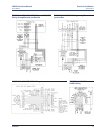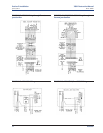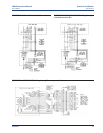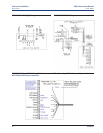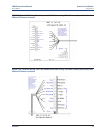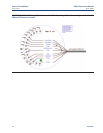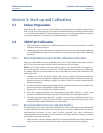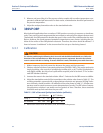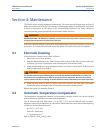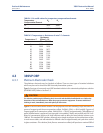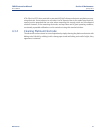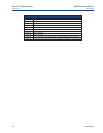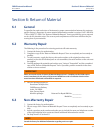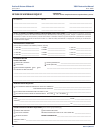
Maintenance 19
3
89VP Instruction Manual Section 4: Maintenance
PN 51-389VP January 2013
The 389VP Sensor requires minimum maintenance. The sensor should be kept clean and free of
debris and sediment at all times. The frequency of cleaning by wiping or brushing with a soft cloth
or brush is determined by the nature of the solution being measured. The sensor should be
removed from the process periodically and checked in buffer solutions.
If the sensor will not calibrate, refer to your analyzer/transmitter instruction manual for proper test
procedures. If it is determined that the sensor has failed, it should be discarded and replaced.
Electrode Cleaning
If the electrode is coated or dirty, clean as follows:
1. Remove the sensor from process.
2. Wipe the glass bulb with a soft, clean, lint free cloth or tissue. If this does not remove the dirt
or coating, go to Step 3 (detergents clean oil and grease; acids remove scale.)
3. Wash the glass bulb in a strong detergent solution, and rinse it in clean water. If this does not
clean the glass bulb, go to Step 4.
4. Wash the glass bulb in a dilute 5% hydro chloric acid solution, and rinse with clean water.
Soaking the sensor overnight in the acid solution can improve cleaning action.
Replace the sensor if it cannot be cleaned.
Automatic Temperature Compensator
The temperature compensator element is a temperature sensitive resistor and can be checked
with an ohmmeter. Resistance increases with temperature.
The 3K element will read 3000 ohms ± 1% at 25°C (77°F), and a Pt100 will read 110 ohms.
Resistance varies with temperature for a 3K and Pt-100 element and can be determined according
to Table 4-2 or the following formula:
R
T
= R
O
[1 + R
1
(T-20)]
Where R
t
= Resistance
T = Temperature in °C
Refer to Table 4-1 for R
O
and R
1
values.
4.1
4.2
Section 4: Maintenance
WARNING
BEFORE REMOVING THE SENSOR, be absolutely certain that the process pressure is reduced to 0 psig
and the process temperature is lowered to a safe level!
CAUTION
The solution used during the following check is an acid and should be handled with care. Follow the
directions of the acid manufacturer. Wear the proper protective equipment. Do not let the solution
come in contact with skin or clothing. If contact with skin is made, immediately rinse with clean water.



